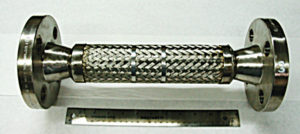Embark on a Journey to Unveil the Hidden Truths
In the intricate symphony of automotive systems, the flex pipe plays a crucial role in maintaining exhaust flow and vehicle performance. However, when this essential component succumbs to the relentless march of time and use, the question of its replacement invariably arises. In this comprehensive guide, we delve into the depths of how much it costs to replace a flex pipe, exploring its multifaceted nature and providing you with the insights to make informed decisions.

Image: si-materialslab.com
Defining the Flex Pipe: Its Purpose and Significance
The flex pipe, often referred to as the exhaust flex pipe or flexible exhaust pipe, is an indispensable segment of the exhaust system. Its primary function is to absorb vibrations generated by the engine and chassis, preventing them from being transmitted to the rest of the vehicle. This remarkable flexibility allows the exhaust system to withstand the rigors of operation, ensuring optimal performance and longevity.
Furthermore, the flex pipe plays a vital role in mitigating exhaust noise. Its corrugated design acts as an effective sound dampener, reducing the intrusive drone that can accompany exhaust flow. By absorbing and dissipating these vibrations and noises, the flex pipe contributes significantly to the overall driving experience, maintaining a serene and comfortable cabin.
Unveiling the Factors Influencing Replacement Costs
The cost of replacing a flex pipe is not a static figure; it is influenced by a multitude of factors that converge to determine the final expense. Understanding these variables empowers you to anticipate and budget for the upcoming repair effectively.
-
Vehicle Make and Model:
The make and model of your vehicle play a significant role in determining the cost of replacing a flex pipe. Different vehicles employ unique exhaust systems with varying complexities, and these variations translate into different replacement costs. Compact cars typically incur lower expenses compared to larger SUVs or trucks, as the exhaust systems in these vehicles are generally more straightforward and accessible.
-

Image: www.carparts.comLabor Rates:
Labor costs constitute a substantial portion of the overall replacement expense. The hourly rates charged by mechanics vary depending on the location, experience, and reputation of the repair facility. Urban areas tend to have higher labor rates than rural ones, and specialized mechanics with extensive experience may command a premium. It is advisable to obtain quotes from several repair shops to compare labor rates and find the most competitive option.
-
Replacement Parts:
The cost of the replacement parts themselves is another key factor to consider. Flex pipes are available in various materials, including stainless steel, aluminized steel, and mild steel. Stainless steel is the most durable and expensive option, while mild steel is the most affordable but less resistant to corrosion. The diameter and length of the flex pipe also influence its cost.
-
Additional Services:
In some instances, replacing the flex pipe may necessitate additional services, such as welding or exhaust system modifications. These extra procedures can add to the overall cost of the repair. It is crucial to discuss all potential expenses with the mechanic before authorizing the work to avoid any unexpected surprises.
Navigating the Cost Spectrum: What to Expect
The cost of replacing a flex pipe can vary significantly depending on the factors discussed above. To provide a general estimate, the typical range falls between $150 and $500. However, it is not uncommon for costs to exceed this range, especially for more complex vehicles or if additional services are required.
It is important to note that the prices quoted here are approximations and may not reflect the exact cost you will encounter. Always consult a qualified mechanic for an accurate assessment and estimate based on your specific vehicle and circumstances.
Expert Insights and Actionable Tips
Seeking expert advice from experienced mechanics can provide valuable insights into the replacement process and help you make informed decisions. Here are a few tips to guide you:
-
Timely Repairs:
Ignoring a failing flex pipe can lead to more severe and costly problems down the road. Prompt replacement is crucial to maintain optimal vehicle performance and prevent further damage to the exhaust system.
-
Preventative Maintenance:
Regular inspections and maintenance can help identify potential issues with the flex pipe early on, allowing for timely repairs and potentially saving you money in the long run.
-
Quality Parts:
Investing in high-quality replacement parts may cost more upfront but will likely last longer and provide better performance, saving you money in the long run by reducing the need for frequent replacements.
-
DIY vs. Professional:
Replacing a flex pipe is not a task for the faint of heart. While DIY enthusiasts with the necessary skills and tools may attempt the repair, it is generally recommended to leave this task to qualified mechanics to ensure proper installation and avoid potential hazards.
How Much Does It Cost To Replace A Flex Pipe
Conclusion: A Sound Investment for Automotive Health
Replacing a flex pipe is an unavoidable expense that all vehicle owners will likely encounter at some point. By understanding the factors that influence the cost of replacement and seeking expert guidance, you can make informed decisions that align with your budget and ensure the continued health of your vehicle. Remember, timely repairs and preventative maintenance are invaluable strategies for maximizing the performance and longevity of your automotive investment.